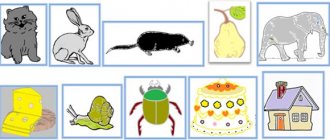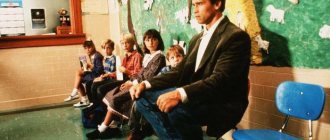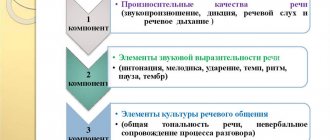Tasks
Examples of tasks that can be used during lessons on the topic “Fruits”:
- Describe the appearance of several fruits using object pictures with their images.
- Compare two similar fruits (apple-peach, pear-quince, tangerine-orange), listing in detail all the common features and differences.
- Name as many characteristics of the fruit shown on the card as possible. One child, children in pairs, or the whole group can list adjectives in a circle.
- Make up a story based on the plot picture, and also come up with several questions for each picture. You can use the following options: “Fruit basket”, “How dried fruits are made”, “From seed to apple”.
- Choose an image of one fruit and come up with as many dishes from it as possible, using the correct name for each (plum marmalade - plum caramel - plum jam).
- Write riddles or short funny poems about fruits on cards.
- Carefully examine one of the pictures, and then, from memory, describe in great detail the fruit that is depicted in it.
- Make up stories in pictures based on several drawings on a topic that are related to each other.
- Using various dried and fresh fruits drawn, come up with a fairy tale about them, compose a short dialogue, and act out (using cards) a short scene.
Fruit basket
Peach
Mandarin
Lemon
Kiwi
Pear
Pomegranate
Banana
Quince
Plum
Cherry
Persimmon
Games
It is useful to organize various educational games for children with images of fruits. Here are some examples:
- Guess what?
Identify the hidden fruit from the description by selecting its image from several laid out on the table.
- Let's fill the basket
Find among the drawn fruits one about which you can say:
– round, rosy, sweet; – bright, aromatic, sour; – leathery, heavy, smooth, etc.
The card with the guessed fruit is put into a box on which a basket of fruit is drawn among the trees.
- Fourth wheel
Select four pictures so that three have something in common, and the fourth is superfluous.
For example: dried apricots, apple, prunes, raisins (three are dried fruits, but the apple is not).
For this game you can use additional cards: berries and fruits, for example.
- Ripe alphabet
Choose any letter, and then, as quickly as possible, remember a fruit or several whose names begin with it. It’s good if the complete “fruit alphabet” in pictures is used for other games and the child is already familiar with it.
- Whose piece?
Based on the image of the cut, you need to guess the whole fruit as quickly as possible.
- Harvesting
Using fruits on a transparent background, create a beautiful still life on a special screen. The full fruit basket is then closed and the child is asked to name everything that is inside it.
Didactic games for preschoolers 4-6 years old on the topic: Fruits, vegetables, berries
Didactic games for preschoolers on the topic: “Fruits, vegetables, berries”
Author: Knis Anna Nikolaevna, senior teacher. Place of work: MBDOU “Kindergarten No. 3 “Smile”, Kalach - on - Don. Description of work: I bring to your attention didactic games for preschoolers on the topic: “Fruits, vegetables, berries.” This material will help educators, children and their parents consolidate children's knowledge about fruits, vegetables and berries in a playful way. Didactic game “The fifth odd one” Goal: Development of skills to classify objects according to essential characteristics, consolidation of generalization words. Didactic material: Cards depicting five objects, four of them belong to one thematic group, and the fifth to some other group. Progress of the game: Children are given the task: “Look at the pictures, name what is depicted on them and determine which object is superfluous. Name the remaining items in one word.” Each participant eliminates the extra item in turn. If he makes a mistake or does not complete the task, his version is offered to the next player to complete. For each correctly completed task they give a chip. The one who collects the most chips wins. Cards for the game: 1. Strawberry, raspberry, kiwi, blackberry, currant. The extra kiwi is because it is a fruit and the rest are berries.
2. Tomato, eggplant, pepper, potato, banana. The extra banana is because it is a fruit and the rest are vegetables.
3. Gooseberries, peach, cranberries, currants, blueberries. The extra peach is because it is a fruit and the rest are berries.
4. Kiwi, apple, pear, peach, tomato. The extra tomato is because it is a vegetable and the rest are fruits.
5. Oranges, apples, radishes, lemon, banana. The extra radishes are because they are vegetables and the rest are fruits.
6. Pear, radish, garlic, cucumber, cabbage. The extra pear is because it is a fruit and the rest are vegetables.
Didactic game “Shop “Fruits, Vegetables, Berries” Goal: Developing children’s skills to accurately describe the appearance (color, shape), taste, and place of growth of fruits, vegetables and berries. Didactic material: Models of fruits, vegetables and berries. Progress of the game: Children choose a seller. The buyer approaches the table on which the models are laid out. Without naming, he describes the fruit, vegetable or berry he wants to buy. For example: “I want to buy berries. They grow in the forest on small bushes. The berries are small, dark blue, round, like peas, slightly flattened on top, juicy and sweet. Jam and compote are prepared from these berries” (blueberries). The child must describe the selected item in such a way that the seller understands what he wants to buy. The seller sells fruits, vegetables and berries (gives the dummy) only to those who have completed the task correctly. Didactic game “Whether in the garden or in the vegetable garden” Purpose: To develop children’s skills to accurately determine the place where fruits and vegetables grow. Didactic material: Pictures of fruits and vegetables, a picture of a vegetable garden and a picture of a garden. How to play: 2 children or 2 groups of children play. The teacher gives one child (group) a picture of a vegetable garden, and another child (group) a picture of a garden. Pictures of fruits and vegetables are laid out in front of the children. A child (group) who has a picture of a garden is collecting vegetables, and a child (group) who has a picture of a garden is collecting fruits. At the end of the game, children check with each other whether they completed the task correctly. Task options: - one group comes up with a riddle about vegetables or fruits, and the other group must find and show the answer in the picture; - tell what can be prepared from vegetables (fruits).
We recommend watching:
Didactic games (verbal) for children 5-6 years old Didactic game for children 5-6 years old Didactic game for teaching literacy to older preschoolers Didactic game for teaching literacy to older preschoolers
Similar articles:
Games to develop motor coordination for children 5-7 years old
Didactic games with natural materials for older children in kindergarten
Educational games for children 5-6 years old in kindergarten
Didactic games to familiarize yourself with flora and fauna for children of the senior preparatory group
Didactic games to familiarize yourself with the outside world in the preparatory group
Summary of a lesson on cognitive development in the second junior group on the topic “Fruits”
Abstract of educational activities in the 2nd junior group on cognitive development on the topic “Fruits”
Purpose: To introduce children to the fruits of fruit trees.
Reinforce knowledge that fruits grow in the garden. Progress of GCD
Educator: The guys have gathered in a circle, I am your friend and you are my friend. Let’s hold hands and smile at each other! (There is a knock on the door and the postman brings a letter)
.
Educator: Children, look, this letter was sent to us from the magic garden. (The teacher reads a letter from Grandma Masha: “Dear children, come to us soon! We have grown a lot of fruit this year, and we do not have time to collect and process them! Thank you!”)
.
Educator: Children, do you agree to go to the magic garden and help Grandma Masha? Children: Yes!!! Educator: Then let's hit the road! We walk along the path, singing songs together! And today we are all together, Let's go to the fruit garden! Educator: Here we are! Look who's greeting us? Children: This is Grandma Masha! Grandma Masha: Hello my dear guys! Children: Hello! Grandma Masha: I am very glad that you came to me. Will you help me harvest my big fruit harvest? Children: Of course. Grandma Masha: Well then, go ahead. Now I will ask you riddles about the fruits that we will now collect! Round, ruddy, I grow on a branch. Adults and little children love me. Children: This is an apple! Grandma Masha: Correct! This Apple! Now we will pick apples! (Children collect apples in a basket)
.
Educator: Children, what can you make from apples? Children: Juice, Jam. Grandma Masha: Well done kids, we dealt with you very quickly! Now listen to the next riddle! The fruit looks like a tumbler and wears a yellow shirt. Having broken the silence in the garden, it fell from the tree... Children: Pear!!! (Children collect pears)
.
Baba Masha: What great fellows you are! Listen to the next riddle! Blue uniform, Yellow lining, Sweet in the middle. Children: This is a plum! (Children collect plums)
.
Grandma Masha: Well done! Today we collected a lot of fruit! What can you make from these fruits? Children: Make jam, cook a pie, cook compote. Grandma Masha: And now we will play the game “Cooking Compote” . We will cook compote. You need a lot of fruit, that's it. We will chop the apples, we will chop the pear, we will squeeze out the lemon juice, we will add the drain and sand, we will cook, we will cook the compote, we will treat the honest people. (Children put fruits in a pan according to the text)
.
Educator: What great fellows you are! Helped us harvest the harvest and make a delicious compote from it! Now it's time for us to head back to the group. We walk along the path, singing songs together! And now we are all together, Let's get into our group! Educator: Here we are back. Children, tell us where we went today and what we did there? Children: Children's answers.
We recommend watching:
Synopsis of GCD in the second junior group Synopsis of an open music lesson for children of the 2nd junior group Synopsis of a game lesson on search and research activities with children of the 2nd junior group Synopsis of a lesson in the 2nd junior group
Similar articles:
Summary of lessons in kindergarten in the 2nd junior group. Group room
Summary of a lesson in the junior group of kindergarten on the topic: “Human nutrition”
Lesson notes about kindergarten. Junior group




